|
|
|
Sort Order |
|
|
|
Items / Page
|
|
|
|
|
|
|
| Srl | Item |
| 1 |
ID:
153268
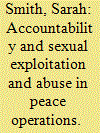

|
|
|
|
|
| Summary/Abstract |
In March 2016, the United Nations Security Council adopted its first resolution devoted entirely to the prevention of peacekeeper sexual exploitation and abuse (SEA) in peace operations. This article examines resolution 2272 by drawing on past practice and the perspective of those at mission sites—namely, Timor-Leste—arguing that the mechanism it establishes—repatriation—is limited in its capacity to prevent SEA and provide justice outcomes. The article demonstrates the pervasive sense of powerlessness regarding SEA and the impunity of those who do perpetrate SEA. The article further situates the issue of SEA by peacekeepers in the post-conflict (gendered) context in which it occurs, arguing that the resolution does not challenge the underlying norms and gendered relations of power that underpin peace operations. Instead, the resolution frames SEA as chiefly an issue of embarrassment for the United Nations and makes scant mention of the populations that peace operations are mandated to protect, as well as the perspectives and needs of victims of SEA.
|
|
|
|
|
|
|
|
|
|
|
|
|
|
|
|
| 2 |
ID:
174334
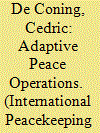

|
|
|
|
|
| Summary/Abstract |
Complexity theory offers a theoretical framework for analysing how social systems prevent, manage and recover from violent conflict. Insights from complexity suggest that for a peace process to become self-sustainable, resilient social institutions need to emerge from within, i.e. from the culture, history and socio-economic context of the relevant society. Peace operations are deployed to contain violence and to facilitate this process, but if they interfere too much, they will cause harm by inadvertently disrupting the very feedback loops critical for self-organization to emerge and to be sustained. To navigate this dilemma, the paper proposes employing an adaptive approach, where peace operations, together with the communities and people affected by the conflict, actively engage in an iterative process of inductive learning and adaptation. Adaptive Peace Operations is a normative and functional approach to peace operations that is aimed at navigating the complexity inherent in trying to nudge societal change processes towards sustaining peace, without causing harm.
|
|
|
|
|
|
|
|
|
|
|
|
|
|
|
|
| 3 |
ID:
131096
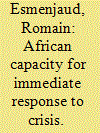

|
|
|
|
|
| Publication |
2014.
|
| Summary/Abstract |
The creation of an African Capacity for Immediate Response to Crisis (ACIRC) is a sign of Africa's willingness to take its destiny into its own hands. Presented as a reaction to the slowness of the development of the African Standby Force (ASF), it is also a response to some of the ASF's conceptual weaknesses. This decision reflects a wish to establish an instrument better equipped to deal with the challenges Africa is facing. Departing from the (sub)regional logic of the ASF results from a desire to take into account the transnational nature of threats, while its enlarged mandate is meant to offer Africa the capacity to intervene in all kinds of conflicts, including by undertaking peace enforcement activities. But the obstacles on the road towards the actual creation and mobilisation of this capacity should not be underestimated. These include material difficulties, but also political tensions, between 'small' and 'big' states as well as between the African Union and subregional organisations. The risk then is high that the ACIRC, whose announcement came as a reaction to France's intervention in Mali, ends up joining the ranks of the many 'anti-imperialist' phantoms haunting the history of the Organization of African Unity/African Union (OAU/AU). Confronted by events considered 'neocolonial' initiatives, African actors have indeed traditionally reacted by launching grand projects that never got off the ground. However, by actually establishing this new instrument, they may also demonstrate that times have definitively changed.
|
|
|
|
|
|
|
|
|
|
|
|
|
|
|
|
| 4 |
ID:
106780
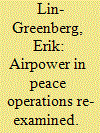

|
|
|
|
|
| Publication |
2011.
|
| Summary/Abstract |
This article examines the role of airpower in peace operations and asserts that, when carried out as part of a multidimensional operation, aviation is a force multiplier that enhances the effectiveness of typically undermanned peace operations forces. Emerging state and commercial actors, even if equipped only with relatively low-tech aircraft, are able to provide intelligence, airlift, information operations and armed support to peace operations. The article examines media reports, academic publications and openly available government and UN documents to assess potential roles for peace operations and to identify political and logistical challenges that must be overcome in deploying airpower.
|
|
|
|
|
|
|
|
|
|
|
|
|
|
|
|
| 5 |
ID:
119284
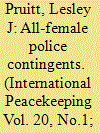

|
|
|
|
|
| Publication |
2013.
|
| Summary/Abstract |
This article focuses on women's involvement in peacekeeping operations and the introduction in 2007 of an all-female formed police unit (FFPU). Possible benefits and challenges of deploying all-female contingents in peace operations are considered and feminist theories of international relations are drawn upon to evaluate arguments for including women in peace and security missions. Media discourses on the Indian FFPU deployed to Liberia in 2007 are analysed, revealing a potential to reshape attitudes about the role of women in peace and security, and emphasizing that femininity need not be incompatible with strength and capacity for protection.
|
|
|
|
|
|
|
|
|
|
|
|
|
|
|
|
| 6 |
ID:
134082
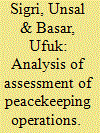

|
|
|
|
|
| Publication |
2014.
|
| Summary/Abstract |
This article proposes a model for assessment of peacekeeping operations. Peacekeeping operations began in 1948, under the authority of the United Nations in order to provide and sustain a peaceful environment throughout the world. International organizations such as the United Nations, the North Atlantic Treaty Organization and the African Union undertake peacekeeping operations in different geographical regions of the world. However, they lack some aspects of the assessment process. There were studies conducted previously in order to determine the principles of the assessment process of peacekeeping operations but none of them presented a comprehensive solution. Therefore, in this study, a clear, comprehensive and detailed assessment model was proposed, which may be applied in future peace operations and shed more light on the subject for future researches.
|
|
|
|
|
|
|
|
|
|
|
|
|
|
|
|
| 7 |
ID:
169245
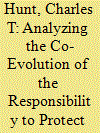

|
|
|
|
|
| Summary/Abstract |
This article analyses the Responsibility to Protect (R2P) in conjunction with the Protection of Civilians (POC) in peace operations. It examines where and how the two concepts have challenged, altered, led to reinterpretations and had feedback effects on each other. Drawing on methods from discourse analysis, the article examines their: gradual institutionalization at the United Nations (UN); deployment in the practices of the Security Council; and, influence over the actions of operations in the field. The analysis shows that the R2P has co-evolved with POC and particularly the implementation of POC through UN peace operations. The article illustrates that the emergence of the R2P and the trends in POC in peace operations have cross-fertilised in discourse and practice at the UN regarding the prevention and response to egregious of human rights abuses. It argues that this has influenced their respective trajectories with ramifications for understanding the normative trajectory and status of the R2P as it enters its third decade in popular lexicon. In particular, it posits that understanding the current and future status of the R2P will be enhanced by insights into how the R2P has shaped, but also been shaped by, other contiguous normative agendas, thematic areas and practices.
|
|
|
|
|
|
|
|
|
|
|
|
|
|
|
|
| 8 |
ID:
104389
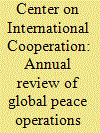

|
|
|
|
|
| Publication |
Boulder, Lynne Rienner Publishers, 2010.
|
| Description |
x, 375p.
|
| Standard Number |
9781588267375
|
|
|
|
|
|
|
|
|
|
|
|
Copies: C:1/I:0,R:0,Q:0
Circulation
| Accession# | Call# | Current Location | Status | Policy | Location |
| 055990 | 327.172/CEN 055990 | Main | On Shelf | General | |
|
|
|
|
| 9 |
ID:
113108
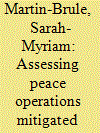

|
|
|
|
|
| Publication |
2012.
|
| Summary/Abstract |
This article seeks to explain why different dimensions of peace operations' success are not always compatible. It puts forward a new typology for better assessing peace operations based on the accomplishment of the mandate and the establishment of order. It provides an explanation of outcomes based on the strategy and the type of interveners. The theoretical framework is applied to 11 peace operations. The analysis shows that mitigated cases are not isolated and result either from the absence of a major military power or from the adoption of a compellence rather than a deterrence strategy.
|
|
|
|
|
|
|
|
|
|
|
|
|
|
|
|
| 10 |
ID:
131316
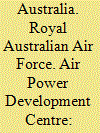

|
|
|
|
|
| Edition |
2nd ed.
|
| Publication |
Canberra, Air Power Development Centre, 2013.
|
| Description |
x, 220p.Pbk
|
| Standard Number |
9781920800925
|
|
|
|
|
|
|
|
|
|
|
|
Copies: C:1/I:0,R:0,Q:0
Circulation
| Accession# | Call# | Current Location | Status | Policy | Location |
| 057782 | 358.4030994/AUS 057782 | Main | On Shelf | General | |
|
|
|
|
| 11 |
ID:
092128
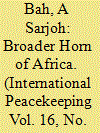

|
|
|
|
|
| Publication |
2009.
|
| Summary/Abstract |
This article analyses the challenges confronting the international community as it tries to deal with the conflicts in the Broader Horn of Africa through peacekeeping. The contention of the article is that peacekeeping efforts in the region are undertaken in a strategic vacuum, thus undermining efforts at resolving the conflicts. Peace operations deployed across the Broader Horn are not synchronized with the political processes, and this is exacerbated by five interrelated challenges: the lack of a political framework; the lack of consent; the issue of protection; the issue of overstretch; and US counter-terrorism policy. The article concludes by calling for the development of a strategic regional framework aimed at reconciling national, regional and international interests that are often in conflict. While deployment of peacekeepers may be part of that framework, it should not be a substitute for viable political processes.
|
|
|
|
|
|
|
|
|
|
|
|
|
|
|
|
| 12 |
ID:
052437
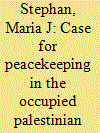

|
|
|
| 13 |
ID:
160800
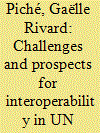

|
|
|
|
|
| Summary/Abstract |
Interoperability is central to UN peace operations. These operations are civilian-led enterprises that pursue complex objectives, which often can only be achieved through the close collaboration of civilian, police, and military actors. As a result, coordination and interoperability between civilian and uniformed personnel in peace operations is not only desirable but often necessary to the success of these missions. Yet, interoperability is not a given. Peace operations face important challenges that can undermine the ability of their different components to work effectively together towards common objectives. Based on observations made during field research in Haiti and time spent at the UN headquarters in New York City, this essay discusses the challenges faced by peace operations in regard to interoperability, factors that facilitate interoperability, and implications for Canada’s announced return to peacekeeping.
|
|
|
|
|
|
|
|
|
|
|
|
|
|
|
|
| 14 |
ID:
021448
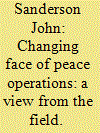

|
|
|
|
|
| Publication |
Spring 2002.
|
| Description |
277-288
|
|
|
|
|
|
|
|
|
|
|
|
|
|
|
|
| 15 |
ID:
072892
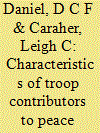

|
|
|
|
|
| Publication |
2006.
|
| Summary/Abstract |
This article addresses two basic questions: Do most of the countries that have participated in peace operations in 2001-04 exhibit particular characteristics? If so, what are the implications for increasing the number of sustained and substantial contributors in the near term? We compared contributors and non-contributors along three dimensions: size of active-duty ground forces, regional location, and societal characteristics (governance, per capita income, internal stability and level of development). Among the most significant of our seven findings is that democratic, rich and middle income, stable and highly and lesser developed states constitute the majority profile of the peace operations community. We conclude that existing contributors are a more promising source of new sustained and substantial contributors than are nominal and non-contributors.
|
|
|
|
|
|
|
|
|
|
|
|
|
|
|
|
| 16 |
ID:
117785
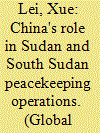

|
|
|
| 17 |
ID:
185890
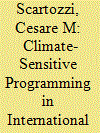

|
|
|
|
|
| Summary/Abstract |
Over the past three decades, United Nations (UN) Peace Operations have become increasingly multidimensional and integrated. Blue helmets, originally deployed to provide security and enforce cease-fires, are now engaging in multi-domain activities aimed at sustaining long-term peace. As part of this trend, the UN Security Council has begun mandating Peacekeeping Operations (PKOs) and Special Political Missions (SPMs) to engage in climate-sensitive programming. Questions, however, remain over the effectiveness of climate-related activities in peace operations. This study, using a large textual dataset, provides a comprehensive assessment and evaluation of the state of climate-sensitive programming in PKOs and SPMs. The findings indicate that while mandates and programming activities related to climate change have been on the rise, most field operations have failed to integrate climate-sensitive programming into their work. Moreover, the agenda on climate security appears to have led to a process of institutional decoupling between organizational arrangements and field activities.
|
|
|
|
|
|
|
|
|
|
|
|
|
|
|
|
| 18 |
ID:
005694
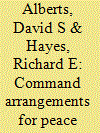

|
|
|
|
|
| Publication |
Washington, D C, National Defence University, 1995.
|
| Description |
x, 136p.
|
|
|
|
|
|
|
|
|
|
|
|
Copies: C:1/I:0,R:0,Q:0
Circulation
| Accession# | Call# | Current Location | Status | Policy | Location |
| 037163 | 355.33041/ALB 037163 | Main | On Shelf | General | |
|
|
|
|
| 19 |
ID:
118001
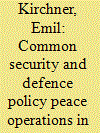

|
|
|
|
|
| Publication |
2013.
|
| Summary/Abstract |
Common Security and Defence Policy (CSDP) missions have increased substantially in number, functions and geographic spread since their inception in 2003. Despite their expansion in numbers and scope, especially in the Western Balkans, few systematic assessments of the contributions that CSDP missions make to peacekeeping and peacebuilding efforts have been undertaken to date. This article addresses that lacuna by assessing the contributions CSDP missions have made in recent years to peacekeeping and peacebuilding in the Western Balkans. It explores whether CSDP missions in that region: make an intrinsic contribution to peacekeeping and peacebuilding in those countries or merely profit (or take credit) from the initial groundwork laid by United Nations (UN) and North Atlantic Treaty Organization (NATO) missions; are adequately coordinated within the European Union (EU) and between the EU and other international organisations, including NATO; are sufficiently embedded or effectively linked to other EU instruments, such as the Stability and Association Process to the Western Balkans; and engender adequate elite or public support or 'ownership' in these countries.
|
|
|
|
|
|
|
|
|
|
|
|
|
|
|
|
| 20 |
ID:
139097
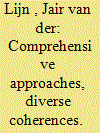

|
|
|
|
|
| Summary/Abstract |
Since 2000, international organisations such as the UN, NATO and the EU, but also countries, have started to apply what has been called the comprehensive approach to crisis management. This article unpacks this comprehensive approach implemented by the Dutch in Uruzgan province, Afghanistan. It first borrows and expands a conceptual framework developed by De Coning and Friis. Subsequently, it maps the different sorts of coherence in the mission by applying the framework. It shows how in practice there was not one single comprehensive approach, but many different forms of interaction between a number of organisational units. Each interaction had its own distinct issues and its own level of coherence. The level of coherence differed depending on the level at which the interaction took place – strategic at headquarters level versus operational at field level – and at what point in the mission it happened – in most cases it moved towards more cohesion.
|
|
|
|
|
|
|
|
|
|
|
|
|
|
|
|
|
|
|
|
|